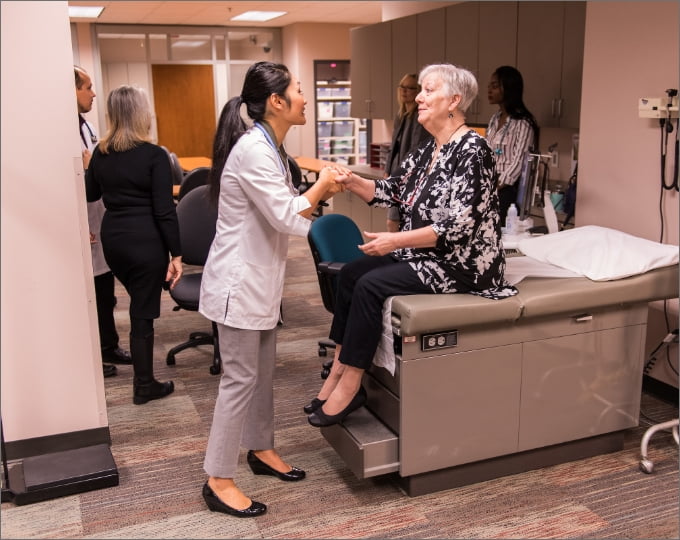
The Role of an FNP: 12 Common Questions Answered
November 15, 2019According to U.S. News & World Report, a nurse practitioner (NP) is the seventh-best job overall and the fifth-best career in health care.1 So, what's behind the prominent standing? NPs are uniquely qualified to provide direct patient care and serve an array of individuals. The family nurse practitioner (FNP) role, in particular, offers an exceptional opportunity for RNs to create a varied, fulfilling and enduring career.
If a career as an FNP piques your interest, read on. This article answers 12 common questions abouts FNPs and explains how to become one through the Texas Woman's University online Master of Science in Nursing - Family Nurse Practitioner program.
A nurse practitioner is regarded as one of the nation's top jobs.
What is the family nurse practitioner role?
FNPs are advanced practice registered nurses (APRN). APRNs have advanced clinical knowledge and skills gained through a postgraduate training program. They render primary and preventative care services as nurse practitioners, clinical nurse specialists, nurse anesthetists and nurse midwives.
FNPs stand out among APRNs because they care for people across the lifespan, from prenatal through adulthood. They often see patients throughout their lives. As a result, FNPs have a distinct capacity to observe changes in patients at every stage of development.

What is the difference between a nurse practitioner and a family nurse practitioner?
FNP is just one type of NP. Approximately 67 percent of NPs in the U.S. are certified FNPs, according to the American Association of Nurse Practitioners (AANP).2
FNPs are not only equipped to care for patients of all ages but to practice across all of the NP specialties.
The NP specialty areas are:
- Acute
- Adult
- Family
- Gerontology
- Neonatal
- Oncology
- Pediatrics
- Psychiatric/Mental Health
- Women's Health
Approximately 67 percent of NPs in the U.S. are certified FNPs.
Why do patients see family nurse practitioners?
Many patients see an FNP as their primary care provider. While FNPs are not physicians, they are rigorously prepared to provide holistic primary care.
In fact, AANP research shows that NP services are safe, high-quality and cost-effective. Patients of NPs have fewer visits to the ER, shorter hospital stays and are “extremely” satisfied with the care they receive.3
In places with a shortage of primary care physicians, FNPs help fill the gap. Today, according to a UnitedHealth Group analysis, 13 percent of Americans live in a county that lacks primary care physicians.4 That number will likely grow.
By 2032, the Association of American Medical Colleges predicts a shortfall of over 120,000 physicians.5 On the bright side, RNs can help address the deficit by obtaining the FNP certification.
FNPs help fill the gap in places with a shortage of primary care physicians.
Where do FNPs work?
The wide-ranging family nurse practitioner role allows for employment in various settings. Most FNPs practice in hospital outpatient clinics.6 The U.S. Bureau of Labor Statistics (BLS) expects this trend to continue because the role of APRNs is expanding in team-based care. Settings that use this model, like ambulatory facilities, will need to hire more NPs.7
In addition to outpatient clinics, FNPs are employed by:
- Physician offices
- State, local and private hospitals
- Educational services
- Community health centers
- Urgent care clinics
The states with the highest levels of APRN employment are New York, California and Texas. Across the country, inner cities and rural areas are typically underserved by health care services. So, demand for APRNs is high here.8
The states New York, California and Texas hire the most APRNs.
What do FNPs do?
Family nurse practitioner duties extend beyond those of an RN. That is because FNPs are qualified to provide direct patient care. FNPs can perform physical exams, order and conduct diagnostic tests, treat primary care issues and even prescribe medications.
Several national organizations – including AANP, the National Academy of Medicine (NAM) and the National Council of State Boards of Nursing (NCSBN) – regard NPs as independent clinicians.
As such, they believe that NPs should be able to practice autonomously and in coordination with other health care professionals. But state government regulates the practice of NPs, so family nurse practitioner duties vary by state.
AANP tracks the current practice environment of all U.S. states and territories. According to the data, NPs practice at three levels of regulation:9
1. Full Practice:
Twenty-three states, including Washington, D.C., permit NPs to work independently. This is the model recommended by NAM and NCSBN. NPs can carry out all the elements of their practice, from assessment and diagnosis to treatment and evaluation.
2. Reduced Practice:
Sixteen states either limit the setting of at least one element of practice or require NPs to practice in collaboration with another health provider.
3. Restricted Practice:
Twelve states have laws that prevent NPs from engaging in at least one element of practice. They also require NPs to work under the supervision, delegation or management of another health provider.

What is a day in the life of a family nurse practitioner?
While the scope of the family nurse practitioner role differs by state and setting, there are commonalities in the daily work.
Active Workday
NPs are busier than ever. According to the 2017 AANP Annual Survey, NPs conducted a record high of over one billion patient visits.10 Full-time FNPs met with an average of 18 patients per day.2 Meanwhile, nearly 59 percent of all full-time NPs reported working overtime.10
FNPs can anticipate a lively workday, especially if they live in a state that authorizes NPs to manage health care teams.
Main Practice Areas
Another shared feature of the FNP workday is the domains of practice. All FNPs are certified to support patients through assessment, diagnosis, planning and evaluation. On a typical day, FNPs might carry out the following essential tasks.11
Assessment:
FNPs collect information from patients to determine their health needs and problems. This process involves reviewing medical records, conducting interviews with the patient and family members and performing exams. FNPs may also order, perform and interpret diagnostic tests and procedures. Standard procedures include skin biopsies, injections and splinting and casting.
Diagnosis:
FNPs analyze the results of various assessments to devise potential diagnoses. From there, they establish a definitive diagnosis, which might require additional tests or information.
Planning:
FNPs design patient-centered plans to treat the diagnosis. They must be safe, individualized, cost-effective, consistent with the evidence, age-appropriate and culturally sensitive. A treatment plan may entail the prescription of pharmacological therapies or patient education and counseling. Treatment almost always involves follow-up.
Evaluation:
FNPs round out patient care by determining the effectiveness of the treatment plan. They do so by assessing the patient response through observation, exams and diagnostic tests. An evaluation might also necessitate treatment modifications, like adjusting therapies or providing a referral to another specialist.

What is needed to take on the family nurse practitioner role?
From start to finish, the process of becoming an FNP has the following steps:
1. Earn an undergraduate degree in nursing.
To pursue a career as an FNP, you will need to obtain an associate's degree or a bachelor's degree in nursing from an accredited program.
2. Become a registered nurse.
Graduates are prepared to sit for the National Council Licensure Examination (NCLEX-RN). Once you pass the exam, you will become a certified RN and can apply for state licensure.
3. Get a graduate degree in nursing.
Next, complete an accredited graduate, postgraduate or doctorate family nurse practitioner program. TWU's online Master of Science in Nursing – Family Nurse Practitioner program can be completed in just under three years. As a graduate, you are eligible to take the Family Nurse Practitioner Certification Exam through the American Association of Nurse Practitioners (AANP) or the American Nurses Credentialing Center (ANCC).
4. Become a certified FNP.
When you pass the Family Nurse Practitioner Certification Exam through AANP or ANCC, you become a certified FNP. In 2024, TWU graduates achieved a 92 percent FNP first-time licensure pass rate.

What skills are needed for the family nurse practitioner role?
To fulfill such a diverse role, FNPs need a distinct blend of skills.
Clinical Proficiency
FNPs must have advanced knowledge across the lifespan. According to the American Academy of Nurse Practitioners, vital knowledge areas include biopsychosocial principles, clinical decision-making, patient and family education, health care economics and legal and ethical issues.11
Emotional Intelligence
FNPs must be able to translate complex information, show genuine concern, function as part of a team and know where to find answers. The BLS recommends that NPs have the following traits.12
- Communication skills
- Critical-thinking skills
- Compassion
- Detail-oriented
- Interpersonal skills
- Leadership skills
- Resourcefulness
Because FNPs work closely with patients and other health providers, certain soft skills are equally important.
How can a registered nurse prepare to become a family nurse practitioner?
Aspiring FNPs will gain all of the required knowledge and skills by completing an accredited FNP master's degree program. The TWU online program is uniquely designed for BSN-prepared nurses. It is well-regarded, affordable and highly ranked.
The program prepares candidates to fill the growing demand for FNPs, not only in Texas but in more than 30 other states. It fosters a transformative experience. Candidates gain advanced clinical expertise, critical thinking, clinical reasoning and professional growth.
U.S. News & World Report includes TWU among the top 100 graduate nursing schools in the country.
By emphasizing a holistic understanding of patient care, TWU helps candidates consider the entire person, their family, environment, community and beyond.
Through engaging courses and clinical fieldwork, candidates:
- Go beyond treating illness to understanding the range of factors that can affect health and wellbeing.
- Develop essential competencies and deepen their understanding of advanced topics such as pharmacology, pathophysiology, patient assessments, treatment methods and applied research.
- Discover a range of resources for assessment, analysis and diagnosis.
- Understand advanced practice nursing from multiple perspectives.
- Build the professional, interpersonal and leadership skills needed for success.
To learn more about the program, view our digital program guide.
What is the career outlook for family nurse practitioners?
FNPs have a fantastic career outlook. Between 2018 and 2028, the BLS expects the employment of all NPs to grow 28 percent. That is nearly six times the average growth rate for all U.S. occupations. With the rising demand for health care services, the country needs NPs to provide preventative care and meet the needs of the aging population.
On top of copious job prospects, FNPs have vast career flexibility because they can treat a range of patients and conditions. They report above-average satisfaction with the stress level of the job and can earn an impressive wage.1
The family nurse practitioner role can also lead to personal fulfillment. It is challenging and allows providers to build meaningful, lifelong relationships with their patients.
Employment for NPs is expected to grow nearly six times the average rate for all U.S. occupations.
How much do family nurse practitioners earn?
Nationwide, full-time FNPs earn an average salary of approximately $115,000.2 In Texas, the average salary among all NPs is just over $111,000.
Texas has two of the country's top-paying nonmetropolitan areas for NPs. On average, NPs employed in the Big Thicket Region and Coastal Plains earn $143,480 and $127,370, respectively.
- Learn more about nurse practitioner salary.

What is the first step in becoming a family nurse practitioner?
The family nurse practitioner role provides a pathway for RNs to build their clinical expertise, directly help patients, make a stable living as well as a difference. If you are already an RN, then your first step towards becoming an FNP is enrolling in a master's degree program.
Read our blog on What You Need to Know About Becoming a Family Nurse Practitioner.
Sources:
1 "Nurse Practitioner Overview." U.S. News & World Report. Accessed 7 October 2019 from: https://money.usnews.com/careers/best-jobs/nurse-practitioner.
2 "Are You Considering a Career as a Family Nurse Practitioner?" (3 July 2019). American Association of Nurse Practitioners. Accessed 7 October 2019 from: https://www.aanp.org/news-feed/are-you-considering-a-career-as-a-family-nurse-practitioner.
3 "What's a Nurse Practitioner (NP)?" American Association of Nurse Practitioners. Accessed 7 October 2019 from: https://www.aanp.org/about/all-about-nps/whats-a-nurse-practitioner.
4 "Addressing the Nation's Primary Care Shortage: Advanced Practice Clinicians and Innovative Care Delivery Models." (September 2018). UnitedHealth Group. Accessed 7 October 2019 from: https://www.unitedhealthgroup.com/content/dam/UHG/PDF/2018/UHG-Primary-Care-Report-2018.pdf.
5 "New Findings Confirm Predictions on Physician Shortage." (23 April 2019). Association of American Medical Colleges. Accessed 7 October 2019 from: https://www.aamc.org/news-insights/press-releases/new-findings-confirm-predictions-physician-shortage.
6 "NP Fact Sheet." American Association of Nurse Practitioners. Accessed 7 October 2019 from: https://www.aanp.org/about/all-about-nps/np-fact-sheet.
7 "Nurse Anesthetists, Nurse Midwives, and Nurse Practitioners: Job Outlook." U.S. Bureau of Labor Statistics. Accessed 7 October 2019 from: https://www.bls.gov/ooh/healthcare/nurse-anesthetists-nurse-midwives-and-nurse-practitioners.htm#tab-6.
8 "Occupational Employment and Wages, May 2018 – Nurse Practitioners." U.S. Bureau of Labor Statistics. Accessed 7 October 2019 from: https://www.bls.gov/oes/current/oes291171.htm#st.
9 "State Practice Environment." American Association of Nurse Practitioners. Accessed 7 October 2019 from: https://www.aanp.org/advocacy/state/state-practice-environment.
10 "Number of Nurse Practitioners Nits New Record High." (19 March 2018). American Association of Nurse Practitioners. Accessed 7 October 2019 from: https://www.aanp.org/news-feed/number-of-nurse-practitioners-hits-new-record-high.
11 "Family Nurse Practitioner Certification." American Academy of Nurse Practitioners. Accessed 7 October 2019 from: https://www.aanpcert.org/certs/fnp.
12 "Nurse Anesthetists, Nurse Midwives, and Nurse Practitioners: How to Become One." U.S. Bureau of Labor Statistics. Accessed 7 October 2019 from: https://www.bls.gov/ooh/healthcare/nurse-anesthetists-nurse-midwives-and-nurse-practitioners.htm#tab-4.
13 "Best Nursing Schools: Master's." U.S. News & World Report. Accessed 7 October 2019 from: https://www.usnews.com/best-graduate-schools/top-nursing-schools/nur-rankings.

